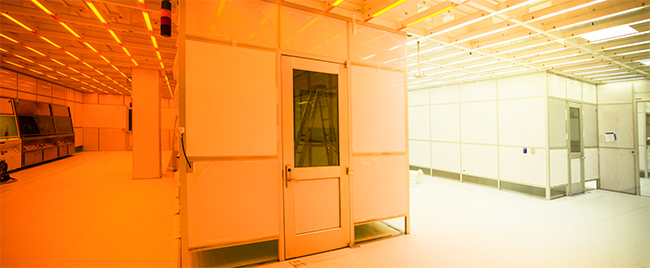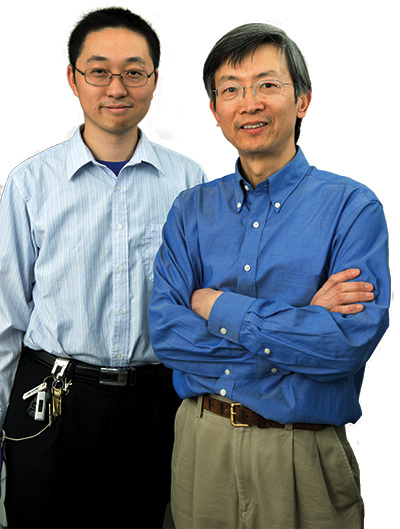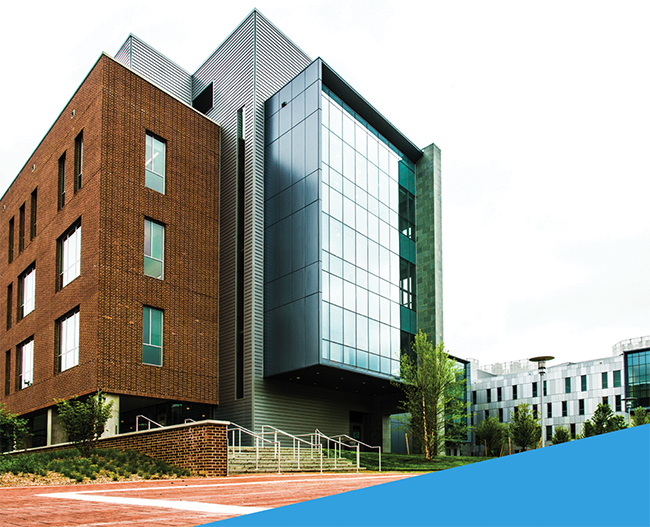



The Bob and Jane Gore Research Laboratories—featuring the most advanced scientific equipment possible—will make kids in a candy store out of many researchers. This gleaming research wing houses three shared laboratory suites with some of the most sought-after microscopes and machinery, which will now be accessible to a larger segment of the UD community, as well as by industry and government partners. Expert staff will be on hand to assist users.

OPEN FOR BUSINESS
ISE Lab's core facilities will be available to university, industry and government researchers such as the Nanofabrication Facility picutred above. To discuss lab capabilities and upcoming projects, contact iselab-info@udel.edu.
Juejun Hu and Chaoying Ni of UD's Department of Materials Science and Engineering envision an array of their sensors near a stream or in a city square, capable of detecting water, soil and air pollutants in real time and relaying that information wirelessly to a computer.
To make their "sensor-on a chip," the team uses specialized tools that will be available in ISE Lab's Nanofabrication Facility, such as a focused ion beam (FIB), to punch holes into a thin strip of chalcogenide glass only a few micrometers thick, or about one-tenth the width of a hair.

SENSOR-ON-A-CHIP DEVELOPERS
From left, UD engineers Juejun Hu and Chaoying Ni will rely on ISE Lab's high-tech facilities to make their sensors for detecting environmental contaminants, and potentially, human diseases.
When light passes through the strip, molecules in the environment selectively absorb one or a few colors of the light. The unique optical absorption signals can then be used to identify the molecules present and their concentration. The researchers plan to group several of the tiny, chip-sized devices together to create a sensor the size of a hockey puck that can detect multiple types of molecules and do so inexpensively and in an environmentally friendly manner.
"It's a new type of sensor," says Ni. "It is very small and, more importantly, it is very sensitive and very specific."
Although the project, which was seeded by the National Science Foundation's EPSCoR program, is in its early stages, Hu is already looking ahead to the practical benefits.
"We'll be able to continuously monitor environmental pollutants, so we'll know if water in a stream is getting polluted or if a chemical plant is leaking," he says. "We can also use it to detect toxic leaks in industrial plants."
Hu adds that once the technology is sensitive enough, chip-scale sensors could be useful in other fields, including biomedicine.
"We could use the devices to check for certain diseases by analyzing a patient's breath," he says. "The sensor would be able to detect trace molecules in the air a patient exhales."— Juan Guerrero
Researchers discuss the sensor on a chip that can be used in environmental monitoring.
Nanofabrication labs are sometimes called "the machine shops of the 21st century," but they operate in ultra-clean rooms that filter out dust and other particles that could contaminate the research. Each piece of machinery performs a different step in the fabrication of nanoscale materials, including lithography, deposition and etching, a process likened to creating a silk screen similar to those used in printing t-shirts, but on an extremely tiny scale. The pattern is created, materials are placed on top through the holes in the "silk screen" and the unnecessary material is etched away. Using this method, countless devices can be manufactured, with uses ranging from health testing to environmental monitoring.
This facility assists in the structural and chemical characterization of materials at scales ranging from micron to angstrom. The suite's transmission electron microscope allows researchers to create high-resolution images. The equipment is particularly sensitive to vibration, so this lab was constructed atop its own foundation, separated from the rest of ISE Lab to minimize interference.
The advanced instruments in this laboratory, from X-ray diffraction to infrared spectroscopy, will be used to reveal the internal structures and physical, chemical and mineralogical properties of materials ranging from soils and air particulates, to quantum dots for advanced computation. The capabilities offered will not be available anywhere else in the world.
Naming opportunities for the laboratory spaces within ISE Lab are still available to major donors. If you're interested in learning more, contact the UD Development Office at (302) 831-0763 or visit the website.
 UD RESEARCH HOME
UD RESEARCH HOME